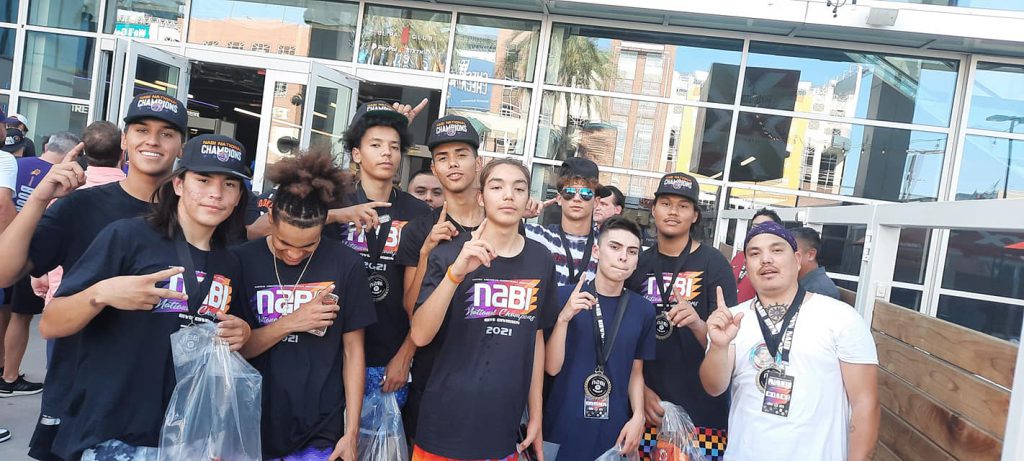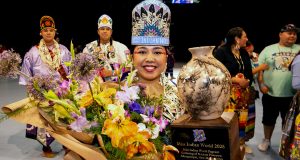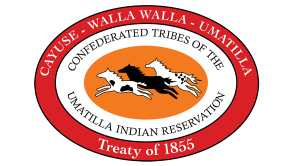By Cary Rosenbaum of the CUJ
PHOENIX – A trio of CTUIR members played significant roles on an inter-tribal team called the “Young Guns,” which captured the 18th-annual Native American Basketball Invitational (NABI) championship in July.
With the victory, former Nixyaawii Community School players Tyasin Burns and Magi Moses, and White Swan High School/Haskell-bound Teal Soaring Eagle got to attend Game 5 of the NBA Finals between the Phoenix Suns and Milwaukee Bucks.
Burns was named the tournament’s Most Valuable Player, scoring 25 in a narrow 61-56 victory over the Oklahoma Runners.
“Not many kids get to do this,” Burns said after the championship. “Our goal was to make this game. That’s what we did. It was just a team game. We all did our parts. That’s how we came out with a W.”
Soaring Eagle said it was a great experience accomplishing a goal right before he leaves to play collegiate basketball.
“I’ll never forget NABI 2021 and especially playing with Young Guns,” he said. “Being able to win the NABI tournament is amazing to me. It is a great accomplishment for where I’m from and I’m glad it can go down in history.”
Moses said the 2021 tournament was a “revenge tour.” The trio of CTUIR members played in the tournament as freshman and lost early in the tournament on a buzzer beater in overtime.
“It was pretty cool,” Moses said. “It was kind of like a revenge tour for me and my boys.”
The Young Guns were coached by Colville tribal member Travis Adams, a Senior Level Archaeology Technician for the Colville Tribes’ History Department. He said 2021 was the first year in which the Young Guns participated in NABI, and the championship was the first for Pacific Northwest tribes at the tournament.
“We’ve been around for six years. We started off as a group of kids from the Colville Reservation,” Adams said. “My nephew and son wanted to play basketball but there was no team in the area so we decided to start our own team. It took us a while to think of a catchy name. … One day I was binge watching the ‘Young Guns’ movie and I thought that would be a cool name for the basketball team. From then on, it stuck with us.”
“After a few years, some of our guys started phasing out. We had a play jump on a team then tried to jump back on our team,” Adams continued. |We had another guy who started going to state for wrestling so his ambition died out. We had a few other guys engaging in activities I didn’t approve so we had to cut them off. And we had guys who flat out just stopped playing basketball.”
It was then Adams began seeking out talents from other reservations to complete the Young Guns.
“Slowly, we built a power house type of team that placed either first or second at almost every tournament we went to,” Adams said. “My goal was to choose players that listened and were loyal to our program; players that loved to practice and trained hard and took the game serious. I think by me holding my players to certain standards, we were able to build a tough team.”
Tough was an understatement. The Young Guns’ run was dominant in the nation’s biggest All-Indian tournament for high school-age Native Americans. They held a 50-34 advantage in the championship game with 11 minutes and 30 seconds to go. When the lead slipped to 54-50, clutch baskets and free throws sealed the game.
Adams said he centered the team around Burns, a CTUIR member with Colville blood who has been with the team for three years.
“He’s always one of the first guys I try to get a commitment from when building a team for any tournament,” Adams said. “His strengths are his ability to listen, his willingness to prepare, to compete, his unselfish style, his mental toughess, and — above all — his love for the game.”
Moses is newer to the team, with the NABI tournament being his second event with Young Guns.
“I know him well because we’ve played against him a lot and we’ve always talked at different tournaments,” Adams said. “A week before NABI, we didn’t have a commitment for a post player, a 5. I know Magi is a big, strong player who can post up and had nice moves around the hoop.
“He was a great addition to our team,” the coach added. “He gave us that size and toughness in the paint that we needed because we knew if we went to NABI with out a guy like him teams would impose their height on us and it could end up with us having a weakness. Magi refused to let anyone bully ball us.”
Adams said he’s known Soaring Eagle for a long time and knew he could ball.
“From the first game he played with us, I was impressed. He listens, he asks questions, he is vocal in the team huddles and he plays hard on both sides of the court. Teal’s strengths are his athletic ability, his ability to notice things that are happening and make quick adjustments, his willingness to play his role at the best of his ability, and most of all his leadership skills, which helped us win NABI.”
Other members of the team were Adams’ son Alonzo of Lake Roosevelt High School in Coulee Dam, Washington; Jayce Pakootas, a Colville from Central Valley High School in Spokane, Wash.; Vander Brown, a Coeur d’Alene member of Lakeside High School in Plummer, Idaho; Hodges Flemming, a Coeur d’Alene member from Gonzaga Preparatory High School in Spokane, Wash.; amd Chippewa members Aiden Prado and Jayson Hall.
CTUIR member Terry Nowland, who came to the tournament with Soaring Eagle, became an adjunct member of the team.
“He was part of our winning run,” Adams said. “He was always there to congratulate our guys when they was playing good and pick them up when they wasn’t playing so good. He was giving high fives and bringing a certain energy that every team needs in a huddle.”
The Young Guns were united under the concept of being river people.
“I told my players when we took the floor together for the last time we was going to be taking the team as a family,” Adams said. “When a reporter asked me after the game, ‘How did we play so well, I just said, we’re all from the same river system and our people have survived there for thousands of years.’ It’s running through our veins.”
After the tournament, Adams told reporters that no one expected the Young Guns to win the tournament.
“That was a spurt of the moment comment,” he said. “Usually, I wouldn’t focus on a topic like that but it was actually noticeable at NABI. You have so many people watching games and making predictions, picking their favorites. All week long we’d hear people choosing other teams to win it; teams with a long history of winning NABI and teams with players being recruited by big-name colleges. It was like we were flying under the radar.”
“I do think we’re on the map now,” Adams added.
He said the tournament was special and will stand out forever. And progress doesn’t stop — even with the pinnacle of NABI championship.
“From here, we go back to the gym,” he siad. “We keep training just as hard as we did before NABI. I have players who want to play college basketball and from what I experienced first-hand, NABI is a perfect way for these kids to get noticed. Colleges are reaching out to me about players on my team.”
Adams noted the remaining team members want to defend their title next year.
“They are saying they are going to work even harder to be ready for next year,” he said. “To me, once you’ve learned how to win basketball games and expect to win, your whole mentality changes so the success won’t change our mentality because our mentality is what created the success.”
The tournament was held July 11-17 at Camelback High School in Phoenix and featured 64 teams in the boy’s upper division bracket.
The NABI Tournament has become the largest all-Native American basketball tournament in the world, according to its organizers, who say it is an educational platform that provides Native American youth a vehicle to succeed beyond the court.




